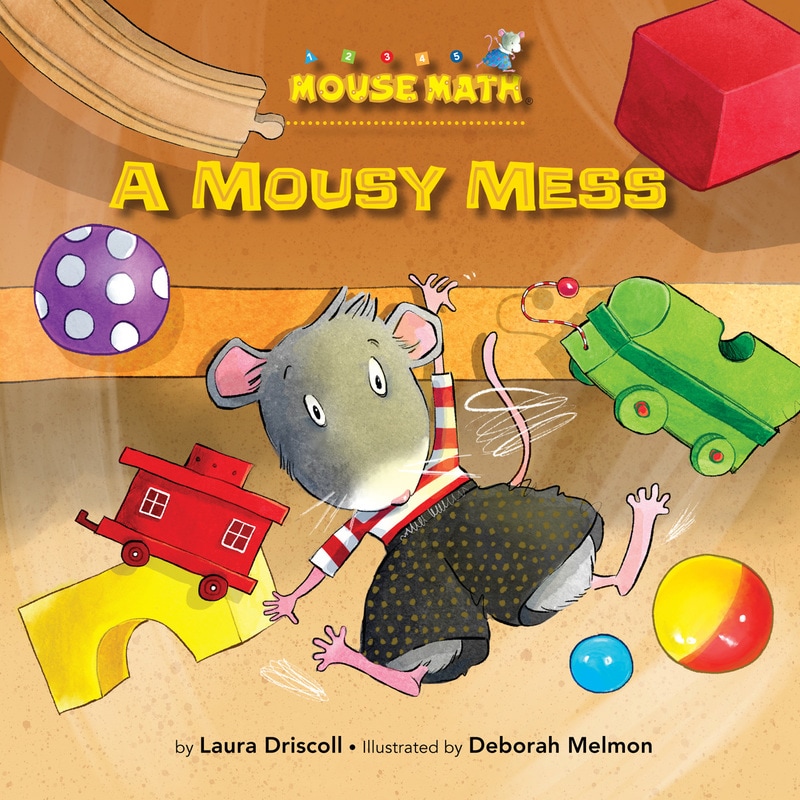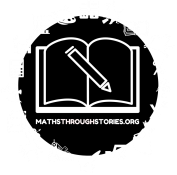A MOUSY MESS
Author: Laura Driscoll
Illustrator: Deborah Melmon
|
Number of pages: 27
Publisher: Kane Press (USA) First published in: 2014 Format: Picturebook Is the mathematical focus explicit in the story? Yes Is this story part of a mathematics story series? Yes (Mouse Math) Preview and/or purchase this book on the Amazon websites: UK, USA, AUS, IND, CAN Synopsis by the author/publisher
While the cat's away, the mice will visit the playroom! But when all the toys come tumbling down, can Albert sort them back into the right bins before the People come home? |
“Albert picked up a blue ball and headed for the blue pile. Then he stopped. Should it go in the round, roll-y pile instead? Or maybe the big pile?”
Official review by MathsThroughStories.org:
Laura Driscoll’s ‘A Mousy Mess’ (2014) is a story about a young mouse named Albert, his sister Wanda and their friend Leo who come out to play with a child’s toys before Albert accidentally knocks over the toys out of their different containers. Panicked, they quickly think of different ways to put these toys back into their containers so the people would not know that they had been there. Initially, some toys are sorted by their colour, while others are sorted by their shapes and sizes. Then, Albert finds a “big blue round roll-y ball” which can go into more than one pile. This prompts the mice to rethink about how best the toys should be sorted and organised. The story encourages young readers to think of other ways the toys can be sorted to help Albert, Wanda and Leo solve the problem. There are so many follow-up activities that teachers can do with their children once they have read the story, for example, children could be asked to sort out a bucket full of various different items from around the classroom using 1-2 pre-determined sorting criteria (e.g. colour and material) and then the children could be encouraged to come up with their own criteria as well. All in all, we highly recommend ‘A Mousy Mess’ to introduce the concept of sorting and classification to children, aged 5+ years old.
Recommended age range:
5+ years old
Relevant mathematics topics:
Sorting & Classifying
Possible teaching activities:
At MathsThroughStories.org, we believe that stories can be meaningfully incorporated in mathematics teaching in different ways. Thus, we are inviting you to share your experience of how you have used this story in your mathematics lesson with other members of the community. By sharing your experience with us, you will be added to our team of On-line Contributors here, where you can also find our submission guideline.
Laura Driscoll’s ‘A Mousy Mess’ (2014) is a story about a young mouse named Albert, his sister Wanda and their friend Leo who come out to play with a child’s toys before Albert accidentally knocks over the toys out of their different containers. Panicked, they quickly think of different ways to put these toys back into their containers so the people would not know that they had been there. Initially, some toys are sorted by their colour, while others are sorted by their shapes and sizes. Then, Albert finds a “big blue round roll-y ball” which can go into more than one pile. This prompts the mice to rethink about how best the toys should be sorted and organised. The story encourages young readers to think of other ways the toys can be sorted to help Albert, Wanda and Leo solve the problem. There are so many follow-up activities that teachers can do with their children once they have read the story, for example, children could be asked to sort out a bucket full of various different items from around the classroom using 1-2 pre-determined sorting criteria (e.g. colour and material) and then the children could be encouraged to come up with their own criteria as well. All in all, we highly recommend ‘A Mousy Mess’ to introduce the concept of sorting and classification to children, aged 5+ years old.
Recommended age range:
5+ years old
Relevant mathematics topics:
Sorting & Classifying
Possible teaching activities:
At MathsThroughStories.org, we believe that stories can be meaningfully incorporated in mathematics teaching in different ways. Thus, we are inviting you to share your experience of how you have used this story in your mathematics lesson with other members of the community. By sharing your experience with us, you will be added to our team of On-line Contributors here, where you can also find our submission guideline.

